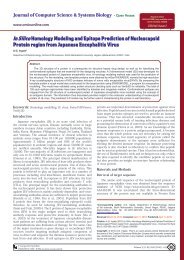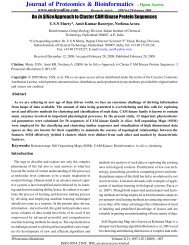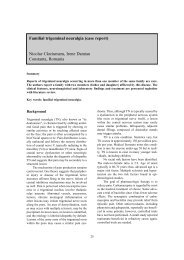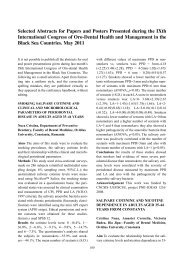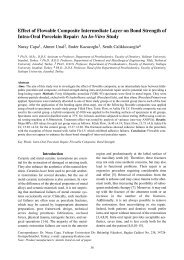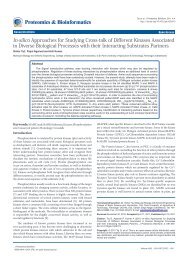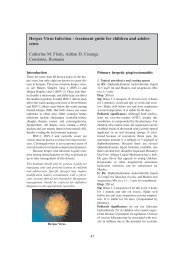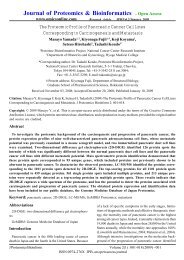Journal of Proteomics & Bioinformatics - Open Access
Journal of Proteomics & Bioinformatics - Open Access
Journal of Proteomics & Bioinformatics - Open Access
Create successful ePaper yourself
Turn your PDF publications into a flip-book with our unique Google optimized e-Paper software.
<strong>Journal</strong> <strong>of</strong> <strong>Proteomics</strong> & <strong>Bioinformatics</strong> - <strong>Open</strong> <strong>Access</strong>www.omicsonline.com Regular article JPB/Vol.1/April 2008The Use <strong>of</strong> Conjunctival Swab for the Proteomic Characterisation <strong>of</strong> Dry EyeSyndrome.Joanna Graham 1† , Robert L.J. Graham 1† , Raymond Beirne 1 , Victoria E. McGilligan 1 , Stephen C. Downes, 1 Jonathan E. Moore 1,2 , Tara C. B.Moore 1 , Ge<strong>of</strong>f McMullan 11School <strong>of</strong> Biomedical Sciences, University <strong>of</strong> Ulster, Coleraine, Northern Ireland2Department <strong>of</strong> Ophthalmology, Royal Group Hospitals, Belfast, Northern Ireland*Correspondence: Pr<strong>of</strong>essor Ge<strong>of</strong>f McMullan, School <strong>of</strong> Biomedical Sciences, University <strong>of</strong> Ulster, Cromore Road, Coleraine, BT521SA, UK; E-mail: g.mcmullan@ulster.ac.uk; Fax: +44-2870-324375†Both authors contributed equally to this manuscript.AbstractIn this study we report the first gel based proteomic analysis <strong>of</strong> an inflammed dry eye utilising a clinically-based non-invasive methodologyfor collection <strong>of</strong> a specimen from the posterior lid and inferior conjunctival mucosa <strong>of</strong> the subject. This multidimensionaltechnique allowed the identification <strong>of</strong> 592 proteins, having a MOWSE score <strong>of</strong> greater than 40, using the heuristic tool PROVALT.Automated curation <strong>of</strong> this list using an inbuilt randomised database searching tool with false discovery rate set at 1% significantlyreduced this list to 86 proteins. Additional manual curation resulted in the final positive identification <strong>of</strong> 75 proteins. These identifiedproteins were functionally classified and physiochemically characterised. This led to the identification <strong>of</strong> a number <strong>of</strong> proteins involvedin cell structure, inflammation, and the innate immune response. Contained within these proteins were a number <strong>of</strong> potential biomarkers<strong>of</strong> not only dry eye syndrome but also lacrimal gland acinar cell function such as lacritin, calgranulin A and lacrimal proline-richprotein 4.Keywords: Conjunctival swab, Dry eye, <strong>Proteomics</strong>.IntroductionThe front <strong>of</strong> the eye or ‘ocular surface’ comprises mucosal epitheliumand various glandular structures that include lacrimal, accessorylacrimal and meibomian glands all <strong>of</strong> which are bathed in athin fluid film. These structures are integrated together and functionas a composite group designed to lubricate, nourish, protectand most importantly produce a clear, smooth optical surface torefract light (Stern et al.,1998;Rolando and Zierhut, 2001)The overlying fluid tear film contains proteins, electrolytes andgrowth factors involved in maintaining the health <strong>of</strong> the ocularsurface. The tear film is produced by lacrimal glands, meibomianglands, andthe surface epithelium and is in close proximity to the systemicblood circulation via the highly vascularised submucosa. Variousproteins within the tear film are recognised to play key roles inocular defence including: lact<strong>of</strong>errin, lysozyme, phospholipaseA2, ceruloplasmin and immunoglobluins such as secretory IgA(Abe et al., 1999; Cullor et al., 1990; Glasson et al., 2002; Haynes etal., 1998; Haynes et al., 1999; O’Callaghan et al., 2003; Seal et al.,1986). Other defence proteins include trefoil peptides, SP-D (surfactantprotein-D), gp340 (glycoprotein 340) and PLA2 and duringinflammation the tear film quickly fills with inflammatory cellswhich leak from the adjacent blood vessels.Recent research has demonstrated a plethora <strong>of</strong> proteins (>400)within the normal tear film (De Souza et al., 2006). The proteinspresent at any given time within the tears may be considered as a‘snapshot’ <strong>of</strong> the status <strong>of</strong> the ocular surface. Alterations in suchproteins undoubtedly contribute to the dynamic <strong>of</strong> the ocularsurface in health and disease. Previous examination <strong>of</strong> the tearfilm in dry eye conditions such as Sogrens have demonstratedalterations in key proteins such as lysozyme, lact<strong>of</strong>errin and EGF(Seal et al., 1986; Ohashi et al., 2003; Schoenwald et al., 1998).The purpose <strong>of</strong> this study was to analyse the applicability <strong>of</strong> aposterior lid margin, inferior fornix mucosal swab to pr<strong>of</strong>ile proteinspresent within the tear film and ocular surface. Most sampling<strong>of</strong> the tear film to date has been through the use <strong>of</strong> capillarytear collection, a laborious and technically difficult approach withlimited clinical applicability (Zhou et al., 2006). An extensive search<strong>of</strong> the literature revealed limited investigation <strong>of</strong> the protein pr<strong>of</strong>ilepresent in a conjunctival sample taken from the inferior conjunctiva<strong>of</strong> human subjects (Grus et al., 2005; Tsai et al., 2006). Theuse <strong>of</strong> a simple non-invasive swab technique to include bothtears and conjunctival cells would simplify this clinical test andproduce a more complete proteomic characterisation <strong>of</strong> the ocularsurface environment to include non secreted cellular proteins aswell as those present within tear film. Recent advances in genomicsand proteomics <strong>of</strong>fer huge potential to enable clinicians to viewbiomarker patterns in both healthy and diseased ocular surfaces.This study was designed to investigate the proteome <strong>of</strong> an eyewith dry eye syndrome clinically characterized by ocular surfaceinflammation, glandular dysfunction and an abnormal tear film.Materials and methodsReagentsAll reagents were purchased from Sigma-Aldrich (Poole,UK) with the exception <strong>of</strong> mass spectrometry grade water andacetonitrile, which were purchased from Romil (Cambridge, UK)and Trypsin, which was purchased from Promega (Southampton,UK).Sample Collection and Patient assessment.A patient who presented with dry eye symptoms wasclinically assessed using a slit lamp examination <strong>of</strong> meibomianglands; lids, lid margins, conjunctiva and tear film;(Foulks andBron, 2003) impression cytological assessment <strong>of</strong> conjunctivalgoblet cells; (Anshu et al., 2001; Saini et al., 1990) tear break-uptime using fluorescein (Kojima et al., 2004) and the Zone-Quickphenol red thread test (PRT) (Menicon, USA) (Hamano et al.,1983). The subject also completed the McMonnies dry eye ques-<strong>Journal</strong> <strong>of</strong> <strong>Proteomics</strong> & <strong>Bioinformatics</strong> (JPB) Volume 1(1): 017-027(2008) -17ISSN:0974-276X JPB, an open access journal © 2008 OMICS Publishing Group
<strong>Journal</strong> <strong>of</strong> <strong>Proteomics</strong> & <strong>Bioinformatics</strong> - <strong>Open</strong> <strong>Access</strong>www.omicsonline.com Regular article JPB/Vol.1/April 2008tionnaire (McMonnies et al., 1986).Sample collection was performed in a clean ophthalmic consultingroom and the examining ophthalmologist wore sterile glovesin order to minimise contamination <strong>of</strong> test samples. In addition,negative control swabs were taken at the time and place <strong>of</strong> subjecttesting to confirm the lack <strong>of</strong> environmental contamination.After instillation <strong>of</strong> topical anaesthetic, the ocular specimen forprotein analysis was collected from the posterior lid margin andlower conjunctival sac using a sterile cotton swab (Bibby SterilinLtd., Stone, UK). The swab was immediately cut into a sterilelysing matrix extraction tube containing ceramic and silica beads(BIO 101 Anachem, UK) and 1ml <strong>of</strong> sodium phosphate buffer usingsterile scissors.Protein extraction and quantificationThe extraction tube containing the swab was processedusing a FastPrep Instrument (Anachem, UK) at a preset speed <strong>of</strong>6.0 for 30 s with a 2 min resting period on ice before the procedurewas repeated. The sample was the centrifuged for 30 minutes at25,000 g to remove cellular debris, the supernatant was decantedand stored frozen at –70°C until required. The total soluble proteincontent was measured using the Bradford assay (Bradford,1976).One dimensional gel electrophoeresisAn aliquot <strong>of</strong> the supernatant (10 ìL) was added to 10ìL Tris-Glycine SDS sample loading buffer (Invitrogen,Renfrewshire, UK) and boiled for 5 min. The sample (20 ìL; 50 ìgtotal protein) was loaded onto a 1 mm thick Nu-Page 4-12 % Bis-Tris gel (Invitrogen, Renfrewshire, UK). SeeBlue Plus 2(Invitrogen, Renfrewshire, UK) was used as a protein molecularmass marker. The gel was electrophoresed, using MES SDS runningbuffer, in an X-Cell II mini gel system (Invitrogen, Renfrewshire,UK) at 200 V, 120 mA, 25 W per gel for 35 min. Proteins werevisualised using SimplyBlue Safestain (Invitrogen,Renfrewshire, UK). The entire lane was excised from the gel andcut into 3 mm fractions.In-Gel Tryptic DigestionExcised gel fractions were washed overnight in 200 ìL<strong>of</strong> a 50% (v/v) methanol and 5% (v/v) acetic acid solution. Thesefractions were then dehydrated by incubation for 5 min in 200 ìLacetonitrile. 30 ìL <strong>of</strong> 10 mM ditiothreitol was added and incubatedfor 30 mins at room temperature, followed by the addition <strong>of</strong>30 ìL <strong>of</strong> 100 mM iodoacetamide for 30 min. 200 ìL acetonitrile wasadded and incubated for a further 5 min. Rehydration <strong>of</strong> gel fractionswas carried out in 200 ìL <strong>of</strong> 100 mM NH 4HCO 3, pH 7.8 for 10min at room temperature. Gel fractions were dehydrated as aboveusingacetonitrile and then dried in a rotary evaporator. 30 ?L <strong>of</strong>20 ng/ìL trypsin in 50 mM NH 4HCO 3, pH 7.8 was added to eachsample and incubated overnight at 37°C. 30 ìL <strong>of</strong> 50 mM NH 4HCO 3was added to the samples and incubated for 10 min. The supernatantwas subsequently recovered into microcentrifuge tubes andtwo further peptide extractions from these gel pieces were carriedout with addition <strong>of</strong> 30 ìL 50% (v/v acetonitrile and 5% (v/v)formic acid) for 10 min. Peptide-containing liquid fractions werepooled, dried under vacuum and re-suspended in 20 µL 0.1%formic acid in 2% acetonitrile prior to storage at -70?C until required.LC-MS AnalysisMass spectrometry was performed using a 3200 Q-TRAPHybrid ESI Quadropole linear ion trap mass spectrometer, ESI-Qq-Qlinearion trap-MS/MS (Applied Biosystems/MDS SCIEX,Toronto, Canada) with a nanospray interface, coupled with anonline Ultimate 3000 nan<strong>of</strong>low liquid chromatography system(Dionex/LC Packings, Amsterdam, The Netherlands). A µ-Precolumn Cartridge (300 ìm × 5 mm, 5 ìm particle size) wasplaced prior to the C 18capillary column (75 µm × 150 mm, 3 µmparticle size) to enable desalting and filtering. Both columns containedthe reversed phase material PepMAP 100 (C 18silica-based)with a 100 Å pore size (Dionex/LC Packings). The elution buffersused in the gradient were Buffer A (0.1% formic acid in 2% acetonitrile)and Buffer B (0.1% formic acid in 80% acetonitrile). ThenanoLC gradient used was 60 min in length: 0 – 55% B in 45 min,10 min at 90% B followed by 5 min at 100% A. The flow rate <strong>of</strong> thegradient was 300 nLmin -1 . The detector mass range was set at400–1800 m/z. MS data acquisition was performed in positive ionmode. During MS acquisition peptides with 2+ and 3+ charge statewere selected for fragmentation.Database Searching, Protein Identification and PROVALT Analysis.Protein identification was carried out using an internalMASCOT server (version 1.9; Matrix Science, London, UK)searching against a human database extracted from the NCBI database(latest version at the time <strong>of</strong> processing). Peptide tolerancewas set at ± 1.2 Da with MS/MS tolerance set at ± 0.6 Da andthe search set to allow for 1 missed cleavage.Carbamidomethylation was set as a fixed modification and oxidation<strong>of</strong> methionine as a variable modification within the searchparameter settings. In order to expedite the curation <strong>of</strong> the identifiedprotein list from MASCOT, the result files were re-analysedagainst this extracted database using the heuristic method knownas the protein validation tool PROVALT (Weatherly et al., 2005).This automated program takes large proteomic MS datasets andreorganises them by taking multiple MASCOT results and identifyingthose peptides that match. Redundant peptides are removedand related peptides are grouped together associated with theirpredicted matching protein, thus, the program dramatically reducesthis portion <strong>of</strong> the curation process. For identificationpurposes the minimum peptide length was set at 6 amino acids,minimum peptide MOWSE score was set at 25 and the minimumhigh quality peptide MOWSE score was set at 40. PROVALT alsouses peptide matches from a random database (in this case theextracted human database was randomised) to calculate falsediscoveryrates (FDR) for protein identifications as previouslydescribed by Weatherly et al.(2005). Briefly, identifications fromsearching the normal and random databases are used to calculatethe FDRs and set score thresholds and thus identify as many‘actual’ proteins as possible while encountering a minimal number<strong>of</strong> false-positive protein identifications. Rather than calculate errorrates at the peptide level, the FDR calculations employed byPROVALT provide a reasonable balance between the number <strong>of</strong>correct and incorrect protein assignments. In this study the FDRwas set at 1%, meaning that 99% <strong>of</strong> the reported proteins identifiedshould be correct.<strong>Journal</strong> <strong>of</strong> <strong>Proteomics</strong> & <strong>Bioinformatics</strong> (JPB) Volume 1(1): 017-027(2008) -18ISSN:0974-276X JPB, an open access journal © 2008 OMICS Publishing Group
<strong>Journal</strong> <strong>of</strong> <strong>Proteomics</strong> & <strong>Bioinformatics</strong> - <strong>Open</strong> <strong>Access</strong>www.omicsonline.com Regular article JPB/Vol.1/April 2008<strong>Journal</strong> <strong>of</strong> <strong>Proteomics</strong> & <strong>Bioinformatics</strong> (JPB) Volume 1(1): 017-027(2008) -19ISSN:0974-276X JPB, an open access journal © 2008 OMICS Publishing Group
<strong>Journal</strong> <strong>of</strong> <strong>Proteomics</strong> & <strong>Bioinformatics</strong> - <strong>Open</strong> <strong>Access</strong>www.omicsonline.com Regular article JPB/Vol.1/April 2008Table 1:Proteins identified from Eye swab proteome with sub-cellular localisation analysis by WoLF_PSORT, SignalP or SecretomePFootnote: Subcellular localisations; E – extracellular, N – nuclear, C- cytosol, ER – endoplasmic reticulum, M – mitochondrial, Cysk –cytoskeleton, PM – plasma membrane. Signal peptide prediction – SP Pred.Results and DiscussionEye examinationExamination <strong>of</strong> the eye demonstrated an abnormal tear film, inflamed ocular surface and abnormal lipid producing glands withinthe lid margins. Meibomian gland disease (MGD) was noted,characterised by significant plugging <strong>of</strong> more than 5 meibomiangland orifices, evidence <strong>of</strong> lid margin irregularity and inflammation,posterior meibomitis, palpebral and bulbar conjunctival inflammationand evidence <strong>of</strong> a mild capillary conjunctivitis. Tearvolume as determined by the phenol red thread (PRT) test was<strong>Journal</strong> <strong>of</strong> <strong>Proteomics</strong> & <strong>Bioinformatics</strong> (JPB) Volume 1(1): 017-027(2008) -20ISSN:0974-276X JPB, an open access journal © 2008 OMICS Publishing Group
<strong>Journal</strong> <strong>of</strong> <strong>Proteomics</strong> & <strong>Bioinformatics</strong> - <strong>Open</strong> <strong>Access</strong>www.omicsonline.com Regular article JPB/Vol.1/April 2008not found to be significantly decreased. An overall reduced tearbreak-up time <strong>of</strong> 6 seconds, positive McMonnies questionnairescore <strong>of</strong> 18 (McMonnies et al., 1986), and presence <strong>of</strong> MGD indicatedthe presence <strong>of</strong> a dry eye syndrome secondary to abnormaltear film.Figure 2. Chart showing the predicted functional categorisation <strong>of</strong> the proteins identified in the eye swab proteome utilising ProteinFun(Jensen et al., 2003)Figure 3. Chart showing the predicted ontology <strong>of</strong> the proteins identified in the eye swab proteome utilising ProteinFun(Jensen et al., 2003)<strong>Journal</strong> <strong>of</strong> <strong>Proteomics</strong> & <strong>Bioinformatics</strong> (JPB) Volume 1(1): 017-027(2008) -21ISSN:0974-276X JPB, an open access journal © 2008 OMICS Publishing Group
<strong>Journal</strong> <strong>of</strong> <strong>Proteomics</strong> & <strong>Bioinformatics</strong> - <strong>Open</strong> <strong>Access</strong>www.omicsonline.com Regular article JPB/Vol.1/April 2008Comprehensive analysis <strong>of</strong> Eye swab proteomeIn this study we report the first gel based proteomic analysis <strong>of</strong> aninflammed dry eye specimen using a sterile cotton swab collectedfrom the posterior lid and inferior conjunctival mucosa. This multidimensionalanalysis involved the eye swab proteome beingfirst separated by one-dimensional gel electrophoresis. The resultantgel was then cut into 3 mm sections, each gel fraction wasthen trypsinized and the extracted peptides separated on a reversedphase C 18column over a 60 min time period prior to beingintroduced onto the mass spectrometer. This methodology allowedthe identification <strong>of</strong> a total <strong>of</strong> 75 proteins (Table 1) from theeye swab utilising a false-discovery rate <strong>of</strong> 1% for protein detection.As previously reported, (Graham et al., 2006) due to the complexnature <strong>of</strong> the peptide mixtures to be analysed, the separation capabilities<strong>of</strong> the LC-MS systems are <strong>of</strong>ten exceeded. In this studyall peptide fractions were analysed in duplicate in order to increaseoverall peptide identifications. In the current study, automatedcuration <strong>of</strong> our initial dataset, by the heuristic bioinformatictool PROVALT utilising random database searching (Weatherlyet al., 2005) led to the identification <strong>of</strong> 86 proteins with furthermanual curation leading to the positive identification <strong>of</strong> 75 proteins.The average number <strong>of</strong> peptides per protein was 6 and theaverage MOWSE score was 357, with the minimum high qualitypeptide MOWSE score for this study set at 40.The 75 identified proteins had a wide range <strong>of</strong> physiochemicalproperties in respect to pI and molecular mass (M r) (Figure 1).This 2-D visualisation showed that the smallest protein identifiedwas small proline rich protein 2a (M r= 7965 Da). The largest proteinidentified was titin is<strong>of</strong>orm N2-A (M r= 3713727 Da). The mostacidic protein identified was calmodulin-like skin protein (pI =4.43) while the most basic was H4 histone family member J (pI =11.36).Of the 75 proteins detected in this study, functional roles for 72proteins (96 %) were known or could be predicted from databaseanalysis. Proteins within the eye swab proteome were assigned t<strong>of</strong>unctional categories utilizing the bioinformatics tool ProteinFun(Jensen et al., 2003). Figure 2 shows that the largest category <strong>of</strong>identified proteins was cell envelope (32.4%), followed by thoseinvolved in translation (18.9%), then those involved in amino acidbiosynthesis (13.5%). The remaining proteins were distributedamongst the other functional categories.The gene ontology <strong>of</strong> this protein dataset could also be identifiedutilizing ProteinFun (Figure 3)(Jensen et al., 2003). Of the 75 identifiedproteins over 38% had no prediction for gene ontology;however, 22% were identified as growth factors, 16% as stressresponse proteins and 7% as immune response proteins.The rapid increase in genomic data over the past decade hasrevealed many important aspects <strong>of</strong> cellular processes, howeverthere are still a significant number <strong>of</strong> potential gene products forwhich we know nothing, save that they are classified as ‘hypotheticalproteins’. In previous work we have underlined the necessityto assign, where possible, an element <strong>of</strong> biological functionalityto such gene products in order to develop both systemsbiology and our understanding <strong>of</strong> cellular processes within thesystem under investigation. Within the current study we haveestablished the presence <strong>of</strong> three proteins that had previouslybeen annotated as hypothetical conserved proteins (Table 1). Theidentification <strong>of</strong> such proteins establishes the biological functionality<strong>of</strong> these ‘hypothetical’ predicted protein coding sequences,and elegantly demonstrates the potential <strong>of</strong> proteomicsto validate bioinformatics predictions.Having established the presence <strong>of</strong> such proteins and wishing tounderstand how they contribute to functional processes we furtherexamined them using NCBI BLASTp. Such an approach allowsconserved domains within protein sequences to be identifiedand thereby enables a degree <strong>of</strong> inferred functionality. Usingthis methodology allowed us to assign putative function to one<strong>of</strong> these proteins, hypothetical protein LOC649897. This proteincontained two IGc domains (CD00098) these are part <strong>of</strong> the immunoglobulindomain constant region subfamily; members <strong>of</strong> theIGc subfamily are components <strong>of</strong> immunoglobulins, T-cell receptors,CD1 cell surface glycoproteins, secretory glycoproteins A/C, and Major Histocompatibility Complex (MHC) class I/II molecules.This once again demonstrates the ability <strong>of</strong> proteomics toinvestigate and validate genomic analyses studies.Sub-cellular Protein Localisation.Sub-cellular localization prediction tools have been used for manyyears to identify those proteins that are retained by and exportedfrom cells. They may also have uses in identifying possiblediagnostic and therapeutic targets as well providing informationon the functionality <strong>of</strong> a protein (Gardy et al., 2005). In the currentstudy a number <strong>of</strong> bioinformatics tools including WoLF_PSORT(Horton et al., 2007), SignalP (Bensten et al., 2004) and SecretomeP(Bensten et al., 2005) were utilized. These bioinformatics toolsendeavour to assign a sub-cellular location for each protein. Thesetools use a set <strong>of</strong> descriptor rules and a variety <strong>of</strong> computationalalgorithms and networks to analyse a proteins’ amino acidcomposition in an attempt to identify known motifs or cleavagesites.All 75 proteins identified in this study were initially analysed usingWoLF_PSORT; 20 were predicted to be cytoplasmic, 21 proteinswere predicted to be extracellular, 18 were predicted to benuclear with the remaining 16 having other sub-cellularlocalisations (Figure 4). These protein subsets were furtheranalysed using SignalP, to predict amino-terminal signal peptides,and SecretomeP, which attempts to identify non-classically secretedproteins. Of those 20 proteins classified by WoLF_PSORTas being cytoplasmic, 15 were confirmed as non-secretory by thisnew analysis, while 5 were predicted to be potential secretoryproteins (all non-classically secreted). Of the 21 proteins initiallypredicted by WoLF_PSORT to be extracellular all were predictedto be secreted, 20 had predicted signal peptide sequences, onewas identified as non-classically secreted. Of the 18 proteins identifiedby initial analysis as nuclear, 13 were confirmed as nonsecretoryproteins, 4 were predicted to be non-classically secretedand one had no information available. Of those 16 proteins predictedto have localizations other than the three above, eight werepredicted to be non-secretory, six were predicted to be secreted (5non-classically) and two had no information available.The 21 proteins identified, from the above analyses, as possessingan N-terminal signal peptide were grouped and analysed inorder to ascertain whether they have the required domain architecturefor eukaryotic signal peptides; namely an N-terminal region(n-region) that usually has a net positive charge, a hydrophobiccore (h-region) containing six to fifteen hydrophobic aminoacids and a C- terminal (c-region) which <strong>of</strong>ten contains helix breakingproline or glycine and small uncharged residues in position –3 and -1 (Table 2). As can be seen all the proteins predicted tocontain signal peptides and therefore be secreted do indeed havethe required architecture (Martoglio and Dobberstein, 1998).Protein characterizationA goal <strong>of</strong> the current study was to ascertain the potential <strong>of</strong> thisclinical sampling technique for the characterisation <strong>of</strong> dry eyesyndrome proteome. As such it would be expected that our dataset would incorporate proteins associated with tears and the ocularsurface, whose functions would include roles in innate immu-<strong>Journal</strong> <strong>of</strong> <strong>Proteomics</strong> & <strong>Bioinformatics</strong> (JPB) Volume 1(1): 017-027(2008) -22ISSN:0974-276X JPB, an open access journal © 2008 OMICS Publishing Group
<strong>Journal</strong> <strong>of</strong> <strong>Proteomics</strong> & <strong>Bioinformatics</strong> - <strong>Open</strong> <strong>Access</strong>www.omicsonline.com Regular article JPB/Vol.1/April 2008nity, inflammation response and <strong>of</strong> course general cellular functions.Below we describe the categories <strong>of</strong> proteins detected inthe current investigation outlining their cellular role and potentialas biomarkers for dry eye syndrome.A number <strong>of</strong> cytoskeletal structural proteins could be identifiedincluding micro- and intermediate filaments (keratins, filaggrin,actin, titin); microtubules (tubulin); catenins (plakoglobin) andTable 2: Proteins identified within the Eye swab proteome containing predicted export signals.Footnote: Putative signal peptides. The hydrophobic H-domain is coloured grey. The signal peptide cleavage sites are the last three aminoacid residues and are in bold. Positively charged amino acids are shown thus (K, R)other cytoskeletal proteins (desmoplakin, myomegalin) (Table 1).Myomegalin is a novel protein that has been found to act as ananchor to localise components <strong>of</strong> the cAMP-dependent pathwayto the Golgi/centrosomal region <strong>of</strong> the cell (Verde et al., 2001).Whilst keratin is known to be a contaminant in many proteomicinvestigations its presence here is not unexpected with Tsai et al.(2006) reporting some 10 keratin is<strong>of</strong>orms in their investigation <strong>of</strong>meibomian gland secretions. It is likely that the origin <strong>of</strong> keratinwithin the sample is the skin surrounding the eye, some <strong>of</strong> whichwill have been ‘harvested’ during eye swab preparation. A recentstudy <strong>of</strong> the tear fluid proteome by de Souza et al. (2006) identifiedall <strong>of</strong> these cytoskeletal structural proteins with the exception <strong>of</strong>keratin is<strong>of</strong>orms, filaggrin and myomegalin.Four proline-rich proteins (PRPs) (Table 1) were also identified inthis study. The biological importance <strong>of</strong> PRPs in the eye lies intheir antimicrobial properties (Zhou et al., 2006). Fung et al.(2004) proposed that PRPs play a significant role in protection <strong>of</strong>the ocular surface and are involved in pathogenesis <strong>of</strong> inflammatoryand autoimmune diseases; whilst Grus et al. (2005) implicatedPRPs in the modulation <strong>of</strong> the eye micr<strong>of</strong>lora. The significance <strong>of</strong>PRPs in eye health diagnosis was also highlighted by Grus andcoworkers (Grus et al., 2005) who proposed that lacrimal prolinerichprotein 4, also detected in the current study, would be a usefulbiomarker for human lacrimal gland acinar cell function.Within this investigation a number <strong>of</strong> calcium binding proteinswere observed. These proteins are known to have a role in theinnate immune response for example annexin is an important mediator<strong>of</strong> the anti-inflammatory actions <strong>of</strong> glucocorticoids, andcalmodulin is also involved in inflammation response (Table 1)(Buckingham et al., 2006). In addition calprotectin (which is acomplex <strong>of</strong> calgranulin A and B) was also identified; this myeloidrelatedprotein complex is known to possess in vitro bacteriostaticand fungistatic properties and is found at high abundancein neutrophils, cells that are rapidly attracted to sites <strong>of</strong> inflammation(Herndon et al., 2003; Gaya and Mackenzie, 2002). Calprotectinis therefore a potential biomarker for a range <strong>of</strong> inflammatory diseasestates such as Crohns’ disease (Gaya and Mackenzie, 2002).Indeed Grus et al.(2005) identified increased abundance <strong>of</strong>calgranulin A in dry eye patients and proposed this protein as auseful indicator for this condition.<strong>Journal</strong> <strong>of</strong> <strong>Proteomics</strong> & <strong>Bioinformatics</strong> (JPB) Volume 1(1): 017-027(2008) -23ISSN:0974-276X JPB, an open access journal © 2008 OMICS Publishing Group
<strong>Journal</strong> <strong>of</strong> <strong>Proteomics</strong> & <strong>Bioinformatics</strong> - <strong>Open</strong> <strong>Access</strong>www.omicsonline.com Regular article JPB/Vol.1/April 2008Figure 4. Overview <strong>of</strong> bioinformatics analysis <strong>of</strong> identified proteins from the eye swab proteome. Cellular localisation was predictedbased upon the use <strong>of</strong> WoLF_PSORT (Horton et al., 2007), SignalP v3.0 (Bendsten et al., 2004) and SecretomeP v2.0 (Bendsten et al.,2004).It has previously been shown (De Souza et al., 2006) that theproteome <strong>of</strong> tear fluid contains a number <strong>of</strong> proteins with proteaseinhibiting properties which was confirmed in our eye swabsample (Table 1). Such proteins included lipocalin 1 which in additionto its protease inhibiting activity, is known to bind a diverserange <strong>of</strong> molecules, functioning as a scavenger <strong>of</strong> physiologicallydamaging lipophilic ligands (Tsai et al., 2006). Cystatin Cand S are extracellular proteins belonging to the family 2 cystatinsthat are ubiquitous in all human secretions and thought to be part<strong>of</strong> a non-immune protective system, functioning by inhibition <strong>of</strong>extra- or intracellular microbial cysteine proteases (Jasir et al., 2003).Three serine proteinase inhibitors (SERPINs) were also identifiedin this study. SERPINA1 (alpha 1 antitrypsin) controls the activity<strong>of</strong> a diverse range <strong>of</strong> proteolytic enzymes and plays an importantrole in infection control by inactivating enzymes activated bybacteria and has been shown to play a role in regulating immuneresponse by inhibiting the migration and transformation <strong>of</strong> lymphocytes(Sen et al., 1988). SERPINB3 and SERPINB5 are members<strong>of</strong> the Ov-serpins and have been shown to inhibit a number<strong>of</strong> proteinases. Their presence in epithelial cells is suggestive <strong>of</strong> arole in barrier/host defence against microbial or viral proteinases(Silverman et al., 2001).<strong>Journal</strong> <strong>of</strong> <strong>Proteomics</strong> & <strong>Bioinformatics</strong> (JPB) Volume 1(1): 017-027(2008) -24ISSN:0974-276X JPB, an open access journal © 2008 OMICS Publishing Group
<strong>Journal</strong> <strong>of</strong> <strong>Proteomics</strong> & <strong>Bioinformatics</strong> - <strong>Open</strong> <strong>Access</strong>www.omicsonline.com Regular article JPB/Vol.1/April 2008It has been reported that 35-45% <strong>of</strong> normal human tears is comprised<strong>of</strong> a number <strong>of</strong> proteins with antimicrobial properties thatform part <strong>of</strong> the innate immune response including lysozyme,lactotransferrin, transferrin, and IgA (Lehrer et al., 1998). Lysozymeis an enzyme present in human neutrophils, whose bacteriocidalactivity is precipitated via the degradation <strong>of</strong> peptidoglycan, amajor component <strong>of</strong> bacterial cell walls (Laible and Germaine, 1985).Transferrin and lactotransferrin interfere in microbial growth byeffectively binding iron (Arnold et al., 1977; Arnold et al., 1982).Lactotransferrin is highly abundant in granules <strong>of</strong> human neutrophilsand secretions from epithelial cells and can also be directlymicrobiocidal (Arnold et al., 1982). Both lactotransferrin andlysozyme are known to function as opsonins, effectively ‘marking’the bacterial cells for phagocytosis by white blood cells(Jenssen, 2005). Lactotransferrin and lysozyme have also beenshown to have synergistic activitiy (Travis et al., 1999). SecretoryIgA is considered the first line <strong>of</strong> immune defense (Kaetzel et al.,1991) and has been reported to be present in those few tearproteomic investigations carried out to date (Zhou et al., 2006;Tsai et al., 2006). It is surprising therefore that IgA was not detectedin the current study, however the polymeric immunoglobulinreceptor (pIgR) which mediates the transfer <strong>of</strong> secretory IgAinto external fluids was identified. In addition IgJ, the synthesis<strong>of</strong> which is critical for primary immune response, due to its functionin assembling both IgA and IgM, was also present (Matsuuchiet al., 1986; Iwata et al., 2002). A possible explanation for ourfailure to detect IgA may be explained by the dimeric/polymericnature <strong>of</strong> IgA during the immune response leading to the formation<strong>of</strong> a very high molecular weight protein that may be intractableby our gel-based method <strong>of</strong> analysis (Stubbe et al., 2000).Also present within the swab sample was lipophilin A and C whichare known to form a heterodimeric molecule in vivo. Whilstlipophilin C has been reported to have weak antimicrobial propertiesnone have been recorded so far for lipophilin A. Indeed atpresent the role <strong>of</strong> this lipophilin heterodimer is unknown howeverit is part <strong>of</strong> the uteroglobin superfamily and has been foundto be capable <strong>of</strong> transporting steroid and other nonpolar molecules.The ubiquity <strong>of</strong> lipophilins within human secretions suggeststhat they are likely to serve important functions in manydifferent tissues and organs (Lehrer et al., 1998; Lehrer et al., 2000).A final protein detected in the swab that possessed antimicrobialproperties was prolactin-induced protein (PIP) which binds toand thereby inhibits the growth <strong>of</strong> certain bacteria, such as Streptococcus(Schenkels et al., 1997). In addition to the antimicrobialrole <strong>of</strong> PIP in secreted fluids it is also known to be a potent inhibitor<strong>of</strong> T lymphocyte programmed cell death induced bycrosslinking <strong>of</strong> CD4 and T cell receptor (Gaubin et al., 1999; Kitanoet al., 2006).A number <strong>of</strong> proteins associated with inflammation and other diseaseprocesses were found (Table 1; apolipoprotein A1 (Burgerand Dayer, 2002); alpha 2 glycoprotein 1 (Hale and Price, 2001);and DMBT1 (Mollenhauer et al., 2000). The protein lacritin, whichwas also detected is normally found in tear films and is known tostimulate new tear production but has also been shown to bedeficient in dry eye syndrome and so may act as a useful biomarkerfor this disease (Koo et al., 2005).Concluding remarksThis proteomic study <strong>of</strong> a dry eye patient demonstrates the variety<strong>of</strong> known and unknown proteins/peptides present in thispathological state. This study highlights the possibility <strong>of</strong> usinga simple non-invasive clinical swab technique in these patientsrather than more complex clinical testing procedures in order toinvestigate dry eye syndrome and potentially other disease states<strong>of</strong> the eye. Further research is required to fully characterise relationshipsbetween clinical signs/symptoms and the proteome. Thedetermination <strong>of</strong> protein changes which imply pathology and/orwhich are harbingers <strong>of</strong> pathology will enable focussed therapeutictreatments and may enable prophylaxis against dry eye conditions.*The work <strong>of</strong> J Graham was funded under a Northern Ireland‘Pro<strong>of</strong> <strong>of</strong> concept’ grant.R. L. J Graham was supported by the Northern Ireland Centre forExcellence in Functional Genomics, with funding from the EuropeanUnion (EU) Programme for Peace and Reconciliation, underthe Technology Support for the Knowledge-Based Economy.ReferencesAbe T, Nakajima A, Matsunaga M, Sakuragi S, Komatsu M.(1999).Decreased tear lact<strong>of</strong>errin concentration in patients withchronic hepatitis C. Br. J. Ophthalmol. 83:684-687.Anshu, Munshi MM, Sathe V, Ganar A. (2001). Conjunctivalimpression cytology in contact lens wearers. Cytopathology12:314-320.Arnold RR, Cole MF, McGhee JR. (1977). A bactericidal effect forhuman lact<strong>of</strong>errin. Science 197:263-265.Arnold RR, Russell JE, Champion WJ, Brewer M, Gauthier JJ.(1982). Bactericidal activity <strong>of</strong> human lact<strong>of</strong>errin: differentiationfrom the stasis <strong>of</strong> iron deprivation. Infect. Immun. 35:792-799.Bendtsen JD, Nielsen H, von Heijne G, Brunak S. (2004). Improvedprediction <strong>of</strong> signal peptides: SignalP 3.0. J. Mol. Biol. 340:783-795.Bendtsen JD, Kiemer L, Fausbøll A, Brunak S. (2005). Non-classicalprotein secretion in bacteria. BMC Microbiol. 5:58.Bradford MM. (1976). A rapid and sensitive method for thequantitation <strong>of</strong> microgram quantities <strong>of</strong> protein utilizing the principle<strong>of</strong> protein-dye binding. Anal. Biochem. 7:248–254.Buckingham JC, John CD, Solito E, Tierney T, Flower RJ, ChristianH, Morris J. (2006). Annexin 1, glucocorticoids, and the neuroendocrine-immuneinterface. Ann. N. Y. Acad. Sci. 1088:396-409.Burger D, Dayer J-M. (2002). High-density lipoprotein-associatedapolipoprotein A-I: the missing link between infection and chronicinflammation? Autoimmun. Rev. 1:111-117.Cullor JS, Mannis MJ, Murphy CJ, Smith WL, Selsted ME, ReidTW. (1990). In vitro antimicrobial activity <strong>of</strong> defensins againstocular pathogens. Arch. Ophthalmol. 108:861-864.De Souza A, Godoy LMF, Mann M. (2006) Identification <strong>of</strong> 491proteins in the tear fluid proteome reveals a large number <strong>of</strong> proteasesand protease inhibitors. Genome Biol. 7: R72.Foulks GN, Bron AJ. (2003). Meibomian gland dysfunction: Aclinical scheme for description, diagnosis, classification andgrading. Ocul. Surf. 1:107-126.Fung KYC, Morris C, Sathe S, Sack R, Duncan MW. (2004).Charachterization <strong>of</strong> the in vivo forms <strong>of</strong> lacramil-specific pralinerichproteins in human tear fluid. <strong>Proteomics</strong> 4:3953-3959.Gardy JL, Laird MR, Chen F, Rey S, Walsh CJ, Ester M, BrinkmanFSL. (2005). PSORTb v.2.0: expanded prediction <strong>of</strong> bacterial proteinsubcellular localization and insights gained from comparativeproteome analysis. <strong>Bioinformatics</strong> 21:617–623.<strong>Journal</strong> <strong>of</strong> <strong>Proteomics</strong> & <strong>Bioinformatics</strong> (JPB) Volume 1(1): 017-027(2008) -25ISSN:0974-276X JPB, an open access journal © 2008 OMICS Publishing Group
<strong>Journal</strong> <strong>of</strong> <strong>Proteomics</strong> & <strong>Bioinformatics</strong> - <strong>Open</strong> <strong>Access</strong>www.omicsonline.com Regular article JPB/Vol.1/April 2008Gaubin M, Autiero M, Basmaciogullari S, Métivier D, Misëhal Z,Culerrier R, Oudin A, Guardiola J, Piatier-Tonneau D. (1999). Potentinhibition <strong>of</strong> CD4/TCR-mediated T cell apoptosis by CD4-binding glycoprotein secreted from breast tumor and seminalvesicle cells. J. Immunol. 162:2631-2638Gaya DR, Mackenzie JF. (2002). Faecal calprotectin: a bright futurefor assessing disease activity in Crohn’s disease. Q. J. Med. 95:557-558.Glasson M, Stapleton F, Willcox M. (2002). Lipid, lipase andlipocalin differences between tolerant and intolerant contact lenswearers. Curr. Eye Res. 25:227-235Graham RLJ, O’Loughlin SN, Pollock CE, Ternan N. G,Weatherly DB, Jackson PJ, Tarleton RL, McMullan G. (2006).A Combined Shotgun and Multidimensional ProteomicAnalysis <strong>of</strong> the Insoluble Subproteome <strong>of</strong> the ObligateThermophile,Geobacillus thermoleovorans T80. J. Proteome Res.5:2465 – 2473.Grus FH, Podust VN, Bruns K, Lackner K, Fu S, Dalmasso EA,Wirthlin A, Pfeiffer N. (2005). SELDI-TOF-MS ProteinChip ArrayPr<strong>of</strong>iling <strong>of</strong> Tears from Patients with Dry Eye. Inv. Ophthal. Vis.Sci. 46:863-876.Hale LP, Price DT. (2001). Zinc alpha-2-glycoprotein as indicator<strong>of</strong> cancer. United States Patent 20020155514.Hamano H, Hori M, Hamano T, Mitsunaga S, Maeshima J, KojimaS, Kawabe H, Hamano T. (1983). A new method for measuringtears. CLAO J. 9:281-289.Haynes R.J, Tighe PJ, Dua HS. (1998). Innate defence <strong>of</strong> the eyeby antimicrobial defensin peptides. Lancet 352:451-452.Haynes RJ, Tighe PJ, Dua HS. (1999) Antimicrobial defensin peptides<strong>of</strong> the human ocular surface. Br. J. Ophthalmol. 83:737-741.Herndon BL, Abbasi S, Bennett D, Bamberger D. (2003). Calciumbindingproteins MRP 8 and 14 in a Staphylococcus aureus infectionmodel: Role <strong>of</strong> therapy, inflammation, and infection persistence.J. Lab. Clin. Med. 141:110-120.Horton P, Park K-J, Obayashi T, Fujita N, Harada H, Adams-Collier CJ, Nakai K. (2007). WoLF PSORT: Protein LocalizationPredictor. Nucleic Acids Res. 35:W585-W587. doi:10.1093/nar/gkm259.Iwata A, Iwase T, Ogura Y, Takahashi T, Matsumoto N, Yoshida T,Kamei N, Kobayashi K, Mestecky J, Moro I. (2002). Cloning andexpression <strong>of</strong> the turtle (Trachemys scipta ) immunoglobulin joining(J) – chain cDNA. Immunogentics 54: 513-519.Jasir A, Kasprzykowski F, Kasprzykowska R, Lindström V, SchalenC, Grubb A. (2003). New antimicrobial cystatinC-based peptide active against gram-positive bacterial pathogens,including methicillin –resistant Staphylococcus aureus and multiresistantcoagulase-negative staphylococci. APMIS 111:1004-1010.Jensen LJ, Stærfeldt H-H, Brunak S. (2003). Prediction <strong>of</strong> humanprotein function according to Gene Ontology categories.<strong>Bioinformatics</strong> 19:635-642.Jenssen H. (2005). Anti herpes simplex virus activity <strong>of</strong> lact<strong>of</strong>errin/lact<strong>of</strong>erricin – an example <strong>of</strong> antiviral activity <strong>of</strong> antimicrobialprotein/peptide. Cell. Mol. Life Sci. 62:3002-3013.Kaetzel CS, Robinson JK, Chintalacharuvu KR, Vaerman J-P, LammME. (1991). The polymeric immunoglobulin receptor (secretorycomponent) mediates transport <strong>of</strong> immune complexes acrossepithelial cells: a local defense function for IgA. Proc. Natl. Acad,Sci. USA 88:8796-8800.Kitano T, Tian W, Umetsu K, Yuasa I, Yamazaki K, Saitou N, OsawaM. (2006). Origin and volution <strong>of</strong> gene for prolactin-induced protein.Gene 383:64-70.Kojima T, Ishida R, Dogru M, Goto E, Takano Y, Matsumoto Y,Kaido M, Ohashi Y, Tsubota K. (2004). A new non-invasive tearstability analysis system for the assessment <strong>of</strong> dry eyes. Invest.Ophthalmol. Vis. Sci. 45:1369-1374.Koo BS, Lee DY, Ha HS, Kim JC, Kim CW. (2005). Comparativeanalysis <strong>of</strong> the tear protein expression in blepharitis patients usingtwo-dimensional electrophoresis. J. Proteome Res. 4:719-724.Laible NJ, Germaine GR. (1985). Bactericidal activity <strong>of</strong> humanlysozyme, muramidase-inactive lysozyme, and cationic polypeptidesagainst Streptococcus sanguis and Streptococcus faecalis:inhibition by chitin oligosaccharides. Infect. Immun. 48:720-728.Lehrer RI, Xu G, Abduragimov A, Dinh NN, Qu XD, Martin D,Glasgow BJ. (1998). Lipophilin, a novel heterodimeric protein <strong>of</strong>human tears. FEBS Lett. 432:163-167.Lehrer RI, Nguyen T, Zhao C, Ha CX, Glasgow BJ. (2000). SecretoryLipophilins: A tale <strong>of</strong> two species. Ann. N. Y. Acad. Sci. 923:59-67.Martoglio B, Dobberstein B. (1998). Signal sequences: more thanjust greasy peptides. Trends Cell Biol. 8:410-415.Matsuuchi L, Cann GM, Koshland ME. (1986). Immunoglobulin Jchain gene from the mouse. Proc. Natl. Acad, Sci. USA 83:456-460.McMonnies CW. (1986). Key questions in a dry eye history. J.Am. Optom. Assoc. 57:512-517.Mollenhauer J, Herbertz S, Holmskov U, Tolnay M, Krebs I, MerloA, Schrøder HD, Maier D, Breitling F, Wiemann S, Gröne H-J,Poustka A. (2000). DMBT1 encodes a protein involved in theimmune defence and in epithelial differentiation and is highlyunstable in cancer. Cancer Res. 60:1704-1710.Ohashi Y, Ishida R, Kojima T, Goto E, Matsumoto Y, Watanabe K,Ishida N, Nakata K, Takeuchi T, Tsubota K. (2003). Abnormal proteinpr<strong>of</strong>iles in tears with dry eye syndrome. Am. J. Ophthalmol.136:291-299.O’Callaghan RJ, Girgis DO, Dajcs JJ, Sloop GD. (2003). Host defenseagainst bacterial keratitis. Ocul. Immunol. Inflamm. 11:171-181.Rolando M, Zierhut M (2001). The ocular surface and tear film andtheir dysfunction in dry eye disease. Surv. Ophthalmol. 45:S203-210.Saini JS, Rajwanshi A, Dhar S. (1990). Clinicopathological correlation<strong>of</strong> hard contact lens related changes in tarsal conjunctiva byimpression cytology. Acta. Ophthalmologica. 68:65-70.Schenkels LC, Walgreen-Weterings E, Oomen LC, Bolscher JG,Veerman EC, Nieuw Amerongen AV. (1997). In vivo binding <strong>of</strong> thesalivary glycoprotein EP-GP (identical to GCDFP-15) to oral andnon-oral bacteria detection and identification <strong>of</strong> EP-GP binding<strong>Journal</strong> <strong>of</strong> <strong>Proteomics</strong> & <strong>Bioinformatics</strong> (JPB) Volume 1(1): 017-027(2008) -26ISSN:0974-276X JPB, an open access journal © 2008 OMICS Publishing Group
<strong>Journal</strong> <strong>of</strong> <strong>Proteomics</strong> & <strong>Bioinformatics</strong> - <strong>Open</strong> <strong>Access</strong>www.omicsonline.com Regular article JPB/Vol.1/April 2008species Biol. Chem. 378:83-88.Schoenwald RD, Vidvauns S, Wurster DE, Barfknecht CF. (1998).The role <strong>of</strong> tear proteins in tear film stability in thedry eye patient and in the rabbit. Adv. Exp. Med. Biol. 438:391-400.Seal DV, McGill JI, Mackie IA, Liakos GM, Jacobs P, Goulding NJ.(1986). Bacteriology and tear protein pr<strong>of</strong>iles <strong>of</strong> the dry eye. Br. J.Ophthalmol. 70:122-125.Sen D, Sarin G., Mathur MD. (1988). Alpaha-1 antitrypsin andserum levels in tear fluid <strong>of</strong> healthy subjects and in persons withconjunctival diseases. Indian J. Opthalmol. 36:22-26.Silverman GA, Bird PL, Carrell RW, Church FC, Coughlin PB,Gettins PGW, Irving JA, Lomas DA, Luke CJ, Moyer RW,Pemberton PA, Remold-O’Donnell E, Salvesen GS, Travis J,Whisstock JC. (2001). The Serpins are an expanding superfamily<strong>of</strong> structurally similar but functionally diverse proteins. J. Biol.Chem. 276:33293-33296.Stern ME, Beurerman RW, Fox RI, Mircheff AK, Pflugfelder SC.(1998). The pathology <strong>of</strong> dry eye: the interaction between theocular surface and lacramil glands. Cornea 17:584-589.Stubbe H, Berdoz J, Kraehenbuhl J-P, Corthésy B. (2000). PolymericIgA is superior to monomeric IgA and IgG carrying the samevariable domain in preventing Clostridium difficile toxin A damaging<strong>of</strong> T84 monolayers. J. Immunol. 164:1952-1960.Travis SM, Conway BA, Zabner J, Smith JJ, Anderson NN, SinghPK, Greenberg EP, Welsh MJ. (1999).Activity <strong>of</strong> abundantantimicrobials <strong>of</strong> the human airway. Am. J. Respir. Cell. Mol. Biol.20:872-879.Tsai PS, Evans JE, Green KM, Sullivan RM, Schaumberg DA,Richards SM, Dana MR, Sullivan DA. (2006). Proteomic analysis<strong>of</strong> human meibomian gland secretions. Br. J. Ophthalmol. 90:372-377.Verde I, Pahlke G, Salanova M, Zhang G, Wang S, Coletti D, OnufferJ, Jin S-L C, Conti M. (2001). Myomegalin is a novel protein <strong>of</strong> theGolgi/Centrosome that interacts with a cyclic nucleotide phosphodiesterase.J. Biol. Chem. 276:11189-11198.Weatherly DB, Atwood JA III, Minning TA, Cavola C., TarletonRL, Orlando R. (2005). A heuristic method for assigning a falsediscoveryrate for protein identifications from mascot databasesearch results. Mol. Cell. <strong>Proteomics</strong> 4:762-772.Zhou L, Beuerman RW, Foo Y, Liu S, Ang LPK, Tan DTH. (2006).Characterisation <strong>of</strong> Human Tear Proteins Using High-resolutionMass Spectrometry. Ann. Acad. Med. Singapore 35:400-407.<strong>Journal</strong> <strong>of</strong> <strong>Proteomics</strong> & <strong>Bioinformatics</strong> (JPB) Volume 1(1): 017-027(2008) -27ISSN:0974-276X JPB, an open access journal © 2008 OMICS Publishing Group



